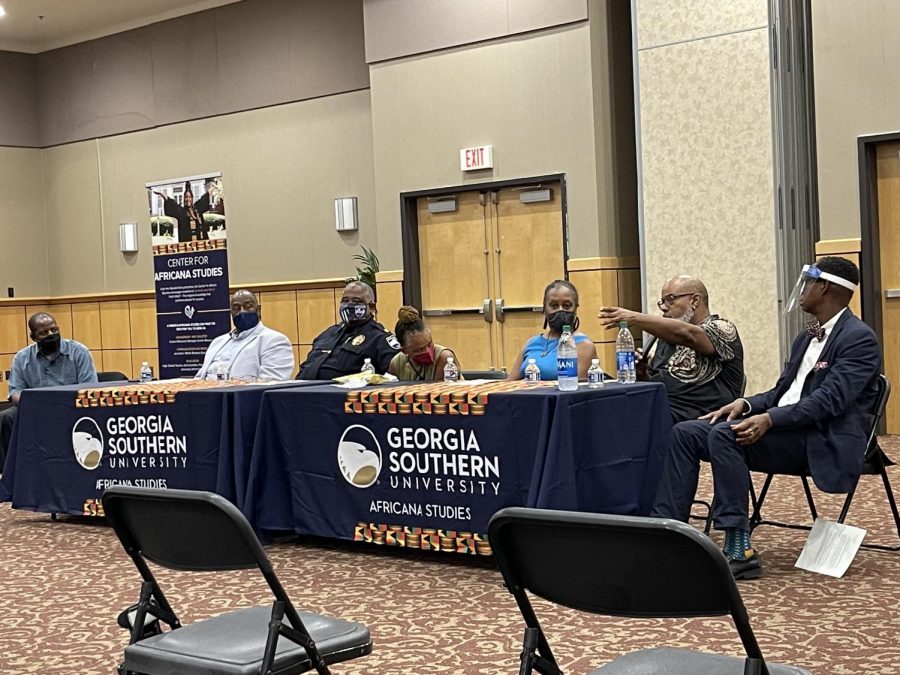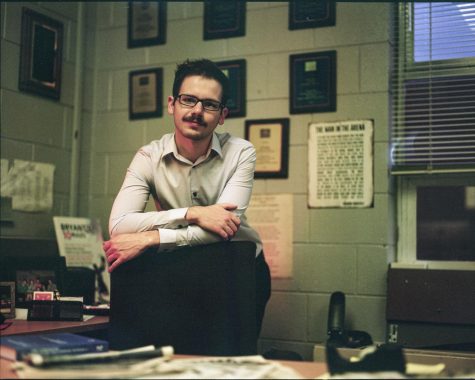“…And Justice for All” Exhibit
A display of pain, healing, conversation and progress in racial inequality
LEFT TO RIGHT Min. Marco George, Chief Alfanza Hagan, Major Ben Harron, Dr. Maxine Bryant, Sharon Butts, Craig “Imara” Butts, Jamal Touré, J.D..
Craig “Imara” Butts brought his “…And Justice for All” exhibit to the Armstrong campus Thursday, Sept. 16 in the Armstrong Center’s ballroom.
The exhibit featured a variety of images of the Black Lives Matter movement, chronicling the nation-wide protests of 2020. Located on the back of many of these images were statements taken from public figures as well as anonymous members of the Black community.
“We took 792 pictures, and brought them down to about 35 or 40. We took two hours of different video clips and cut them down to about 45 minutes,” explained Butts.
The George-Anne Inkwell was not given a release to publish photographs of the exhibit.
The statements attached to the photos varied in their content, but all had something to do with race relationships in the present day. Some were personal accounts from Black individuals of how they choose to interact with the police on a daily basis.
“I’m teaching my kids that you do not call the police unless the situation is so bad that you don’t mind someone dying… If you aren’t in mortal danger, consider calling the fire department. In many cases, they can handle someone who is sick or acting strangely, without endangering anyone,” said one message, credited to an anonymous “tb92.”
Messages were not exclusively negative or distrusting of the police. The point of the exhibit was not to vilify any person or group in particular, but instead sought to communicate the complexity of racial inequality in today’s society.
The exhibit also explored how collective grief can unite people, and how tragic circumstances brought people of different backgrounds together into one community.
Attendees were given a program that further explained the intended message.
“From a community standpoint, people are choosing not to make the events that led to their grief a way of life. They come together with a common purpose under the auspices of working through the situation,” the program explained.
A discussion panel of experts was also featured at the exhibit. Butts, the artist who created the exhibit, was present, as well as his wife Sharon Butts, who teaches high school, and two representatives from Georgia Southern: Dr.
Maxine Bryant, assistant professor of Criminal Justice, and Jamal Touré, J.D.,who teaches Georgia Southern’s Africana Studies program,
Two members of law enforcement, Alfonza Hagan, police chief in Walthourville, GA, and Major Ben Harron from Savannah rounded out the panel. Minister Marco George served as moderator.
After guests were given an opportunity to observe the exhibit, the panel hosted an open discussion on racial issues, much of it focused on police behavior and reform.
“Justice has not been ‘for all’ in the United States of America,” said Dr. Bryant. “That seems to be delegated to a certain part of the population.”
The discussion dove deep into how police officers, as well as their precincts, can better serve Black communities in America. Sincere community engagement between officers and the people they serve was a major talking point.
“When you haven’t been exposed to a culture, and you’re coming into a community you’re not familiar with, in police training we’re taught to train for the unexpected and be professional. But when heightened emotions come in, and that fear takes hold, you don’t know how you’re going to respond,” said Major Harron, explaining the importance of being familiar with a community.
Chief Hagan explained that police officers need to be individuals with high levels of bravery, empathy and sincerity.
“People have got to have the right heart to be in this business. It’s a tough business, it’s a lot of stress, but you have to have a lot of heart,” said Hagan.
The panel did not only discuss police activity. Members of the panel were quick to point out that issues of race are old and widespread in America, and progress starts with conversation.
“Too often, we take the ‘Ostrich Approach.’ We stick our heads in the sand,” said Dr. Touré, who along with Dr. Bryant, preached self-love as an important part of the national healing process.
“If I value ‘me’ then it’s going to be more difficult for me to take you out. If I don’t value ‘me,’ It will be harder to value others,” Dr. Bryant explained. “I have to first love myself if I am to love you and you and you.”
Sharon Butts offered her own perspective as a high school teacher, and mentioned that families and law enforcement must properly nurture and care for children to help them stay out of trouble.
“We see a difference between parents who are involved and who are not involved, and it manifests in the children,” she explained. On relationships with officers, she said, “There has to be a way for police officers to get to know who these children are before they want to know what they did.”
Responding to a question regarding community engagement, Chief Hagan offered his perspective as to why he is still in law enforcement.
“I encourage our officers to go out into the city and engage… That’s why I’m still in law enforcement. I could be retired sitting at home. But I wanted to make a difference.”
Social change regarding racial inequality has a long, difficult and important history, especially in Savannah. While this history is painful for so many, Dr. Bryant stresses that Black Americans especially should find the beauty in their history.
“History matters. Before there was American History, there was Black History.”
It was a productive conversation between different members of the Black community in Georgia with widely different perspectives on these issues.
The exhibit and panel will be at the Statesboro campus Thursday, Sept. 23 at 6:00 p.m.




